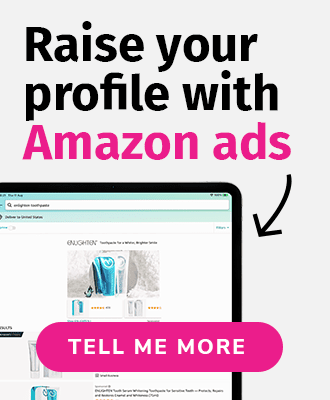Are you a new seller on Amazon but running into some questions? Are you wading into FBA and wondering how to get your products to Amazon and to customers? You’re not alone. Seller Central is full of information, policies, and—for even experienced sellers—a lot of confusion. This blog will explore some basics of barcodes for selling on Amazon and leave you with some tips and insider knowledge to alleviate confusion.
What is a barcode?
Every product on the globe has one, and you’ve probably seen barcodes all your life. But what is their function and how are barcodes created? Manufacturers and retailers, both online and at brick-and-mortar stores, use barcodes to identify and track product inventory. There is actually a lot of information tied to those little black-and-white stripes, and Amazon relies on them to keep tabs on the millions of items they’re fulfilling around the globe.
A barcode features a scannable portion and numerical portion. To create a barcode on Amazon, or any platform, you will need a Universal Product Code (UPC).
Manufacturer barcodes include a number of eligible options, which all fall under the umbrella of GTIN. A GTIN stands for Global Trade Item Number. These can include a UPC, GCID, EAN, JAN, or ISBN. On Amazon, some sellers may also have the option to create a FNSKU, which is an Amazon-specific barcode that can help sort the manufacturer's authentic inventory from counterfeiters.
Each and every item needs its own barcode
This is the first rule of barcodes. Each product is unique, and every item will need its own identifier. Unless the product is exactly the same. This point can get complicated quickly, for example:
If you are selling a water bottle, it will need its own barcode.
- One barcode can cover an infinite number of these products, as long as it’s the exact same product with no differences between each one; ie., all of these water bottles are the same brand, light blue, and 24 ounces.
If you are selling the water bottle in other variations, each variant will need its own barcode.
- For example, the water bottle is of the same brand and style but is red and 24 ounces. You will need a new barcode for this item.
If you are bundling a blue and a red water bottle together to sell as one unit, you will need an entirely different barcode for the bundle.
- Even though each individual product has its own barcode, you will need an entirely different barcode for the bundle that refers to only the two-pack.
This can be even more complicated by the number of variations. On Amazon, many product categories accept variations for different pack sizes, colours, sizes, lengths, scents, etc. Depending on what you plan to sell, this may expand exponentially quite quickly. Depending on your product catalogue, you may need hundreds of barcodes, or you may need just one or two.
Do I need a new barcode for the product I’m listing on Amazon?
There are two types of sellers on Amazon: Manufacturers and wholesalers or distributors. If you are a manufacturer, sourcing and buying products and branding them as your own, then you will likely need to create barcodes for your items when they are initially set up to sell to customers (on Amazon or in physical stores).
If you are a wholesaler or distributor selling items that are not your own brand, there is likely already a barcode created for the product you wish to sell. For instance, if you are buying Nike shoes and reselling them through your Amazon seller account.
When you create a Seller Central account and go to list a product for sale, Amazon will guide you through a number of options to help you list a product that is appropriately situated within either a new ASIN or an existing ASIN. If you decide to ignore this and start creating new barcodes and ASINs regardless, you will get your listing removed and you may get your account suspended entirely. It pays to know what you're doing when setting up an account and products, so if you're unsure, please enlist help or ask questions first.
How can I buy a UPC?
Once you know what category of seller you are and what you’re trying to list, you may need to create a UPC and barcode from scratch. You can purchase and create this from GS1. At GS1, you are paying for a prefix for your business and the right to use that specific code on your products. GS1 has pricing for small needs, such as 1 to 10 UPCs and on up, for thousands of UPCs, if needed.
Because UPCs are global and GS1 has offices all over the world, you may investigate other locales to see if the UPCs are cheaper for the amount you need. All GS1 UPCs will work for listing products on Amazon. There are other channels, for instance, companies that buy UPCs from these governing bodies for you. But to simplify things, you might as well just purchase from GS1 in your locale directly.
How to list a product with your UPC
Once you have the GTIN in hand, you can create a new listing in Seller Central. You will enter this number along with vital information about your product, such as the title, description, and item details. Be sure to avoid common listing optimisation errors and do a thorough job with creating content for your products. As a full-service agency specialising in Amazon, eCommerce Nurse is well-suited to help!
When you create a new product, Amazon will generate an ASIN for you. An ASIN is an Amazon Standard Info Number (because we don’t already have enough acronyms). Each Amazon product will have a unique 10-character alphanumeric unique identifier that is used specifically for and within Amazon. ASINs can be further broken down into parent and child ASINs for products that have one overall item or style (the parent) with multiple choices when it comes to colour, size, pack size, etc. (the child ASINs).
How to print labels for Amazon FBA
If you are selling your product via Amazon FBA, you will then use this ASIN and barcode to label your items. Each product needs its own scannable label to keep track of it in transit and at Amazon fulfillment centres (there is also an option to have Amazon label products for you once they are received, for a fee).
Once you create your UPC and create your Amazon listing, you can print labels to Amazon’s specifications to send your product to Amazon.
For specific label information, see Seller Central’s FBA product requirements. You must follow Amazon's guidelines with label printing, or you may be in violation of Amazon’s terms of service. These guidelines include having sufficient white space around the scannable barcode, as well as including the item name and condition, plus where it is attached to the product. We recommend following the steps in Seller Central, as the exact requirements will depend on your category, product, and Amazon locale.
Need more help?
Whether you are a seasoned pro or a new seller, you’re bound to run into some issues. It’s important to set your products up correctly and avoid product or account suspensions. If you need account help or additional services, please contact us at eCommerce Nurse. Our team of ex-Amazonians and Amazon experts can help you get on the right track from day one.




